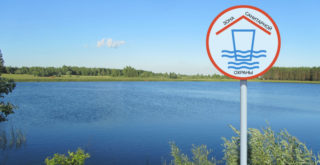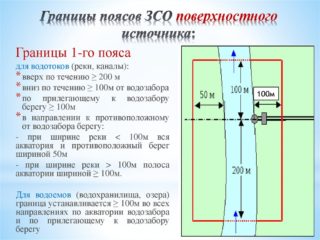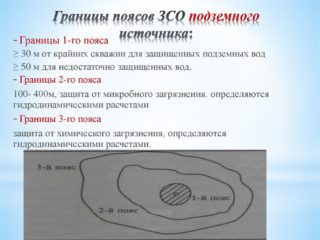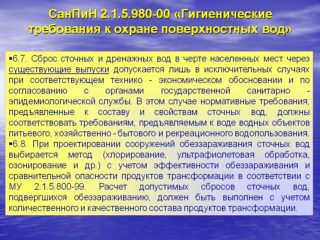Water sources are objects of strategic importance, since the life and health of the country's population depends on the quality of water. The protection of the safety of natural resources is guaranteed by the Constitution of the Russian Federation, is the concern of the State and is ensured by the sanitary rules and regulations of the SanPiN of the zone of sanitary protection of water supply sources and drinking water pipelines. The Sanitary Protection Zone (SPZ) is a site with a special land use regime. It is released around the places of water intake and transportation to create a barrier against industrial pollution, toxic substances, pathogens.
ZSO belts and definition of boundaries

To ensure the environmental safety of facilities around drinking water wells or a water conduit connecting the water intake with the main water supply main, adjoining areas are allocated, running in a strip along the buildings.
When calculating the width of the SPZ belts for the water intake source, they rely on the following parameters:
- source type: surface, deep-underground;
- hydrological conditions and phases of the water regime: high water, low water, seasonal or rainfall floods;
- geological conditions: the relative position of the water-resistant and aquifers;
- terrain relief;
- climatic conditions: temperature regime, wind rose, amount of precipitation;
- type of pollution: bacteriological, chemical.
In accordance with the norms (SanPiN 2.1.4.027-95), the ZSO is divided into several zones, characterized by security measures with different severity of the regime.
Strict regime - fenced secured area
If there are several wells, the most extreme is taken as the boundary reference point. For protected sources, where the aquifer is bordered by two impervious strata (for example, artesian waters), in agreement with Rospotrebnadzor, it is permissible to change the size of the first belt downward if there is an expert opinion on the zero probability of contamination from the surface.
In the case of unprotected sources, where there is groundwater above which the soil does not have waterproof properties or there are hydrogeological windows in the upper water-resistant layer, the maximum possible zone of sanitary protection is set up. This is due to the fact that such sources are fed by surface water, into which impurities can easily get.
If underground reservoirs are replenished through artificial canals, the protective belt can increase up to 150 m.
Restriction mode - unenclosed area, indicated by signs
Third belt - buffer against chemical poisoning. The estimated width in some places coincides with the second belt, but mainly amounts to 5 km to the reservoir, depends on the range of propagation of a harmful compound in the aquatic environment, which retains its stability, or decays as a result of physicochemical processes occurring in the source (for example, the fallout of inactive sediment) ... It provides a protective zone, the size of which ensures that hazardous substances of a chemical nature reach the water intake only after the expiration of its service life, that is, not earlier than 10,000 days (the average life of the water intake is 25 years).
Of all types of soil, clay has the best waterproof properties.
Sanitary zones are calculated at all stages of construction, as well as the functioning of water intakes. Information about the boundaries of the WSS is reflected in the project along with an action plan to improve the sanitary state of the protected area and the rules for its use.
Simplified design is permissible only for wells with industrial water used for irrigation or production purposes.
Main events on the territory of the ZSO
The territory of the first belt must be provided with:
- protection;
- fencing;
- paved footpaths;
- landscaping, with the exception of tall trees;
- a drainage system to divert surface water from a water supply source outside the zone;
- connection to a centralized sewerage network, and in its absence, sealed accumulators located outside the fence, which, as necessary, are serviced by a sewage service.
On this site, any construction, permanent residence of people, bathing and washing, grazing, the use of fertilizers, poisons, chemicals, detergents is prohibited.
In the ZSO of the second belt, the following activities are carried out:
- plugging - a plug with a protective cushion made of cement, clay or molten plastic - inoperative wells, to isolate the aquifer from the penetration of contaminants of a chemical or microbiological nature;
- permitted: boating, fishing, construction of comfortable settlements, industrial enterprises, agricultural facilities, provided with sewerage and water supply systems;
- prohibited: deforestation, the creation of filtration or irrigation systems, the development of deposits of natural resources, the use of toxic chemicals or fertilizers, the construction of warehouses for fuels and lubricants, livestock farms, landfills for solid or liquid household waste on the surface, as well as underground.
Activities in the third zone basically coincide with the second, but it additionally allows logging operations, the use of chemicals permitted by sanitary and epidemiological supervision to clean up reservoirs or drainage canals from vegetation and bottom sediments.
A restrictive measure common to the belts is a ban on the placement of cemeteries, cattle burial grounds, pits for storing manure or silage on their territory.
Compliance with sanitary norms and rules is mandatory for both individuals and representatives of large and small businesses.











